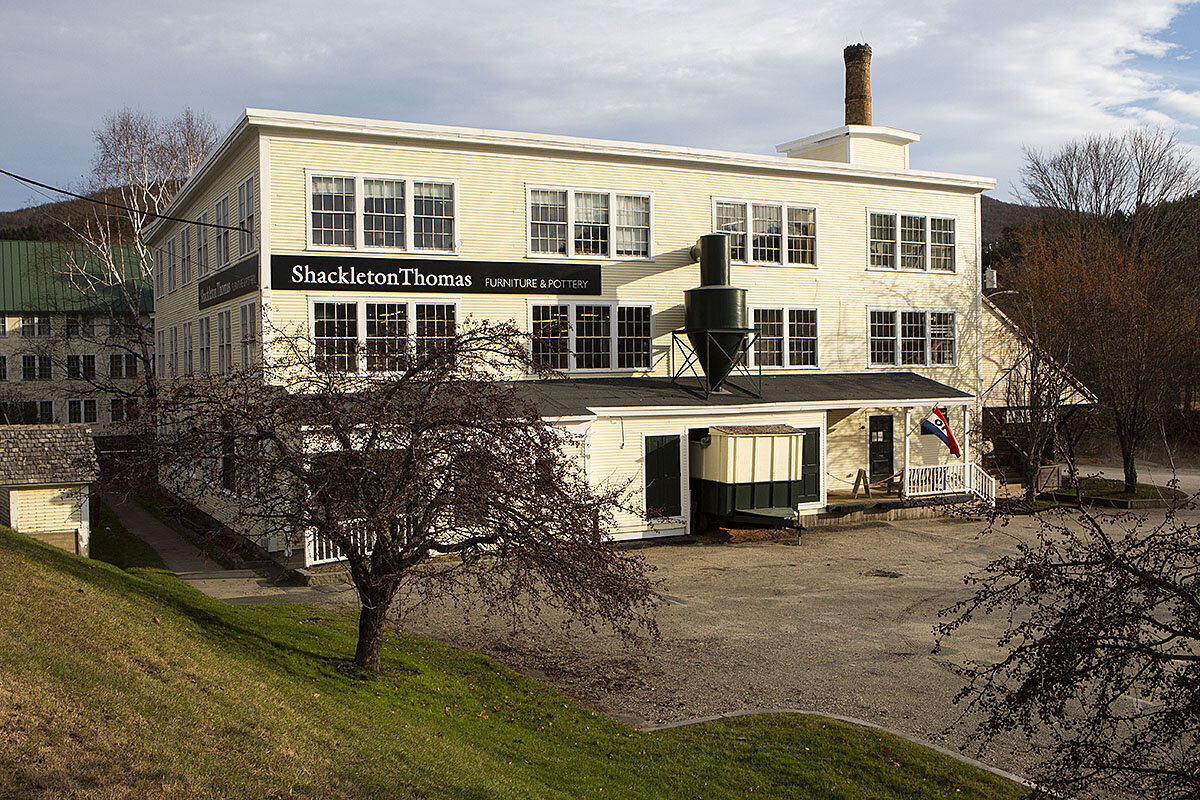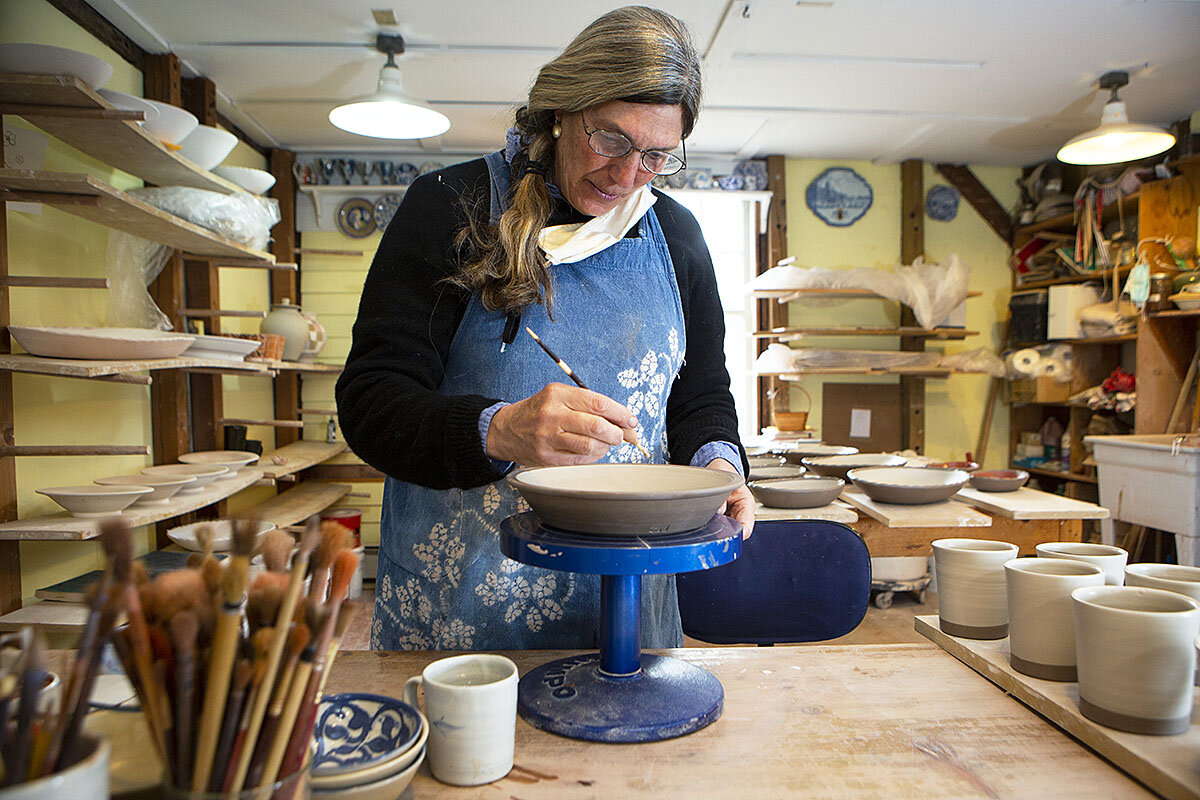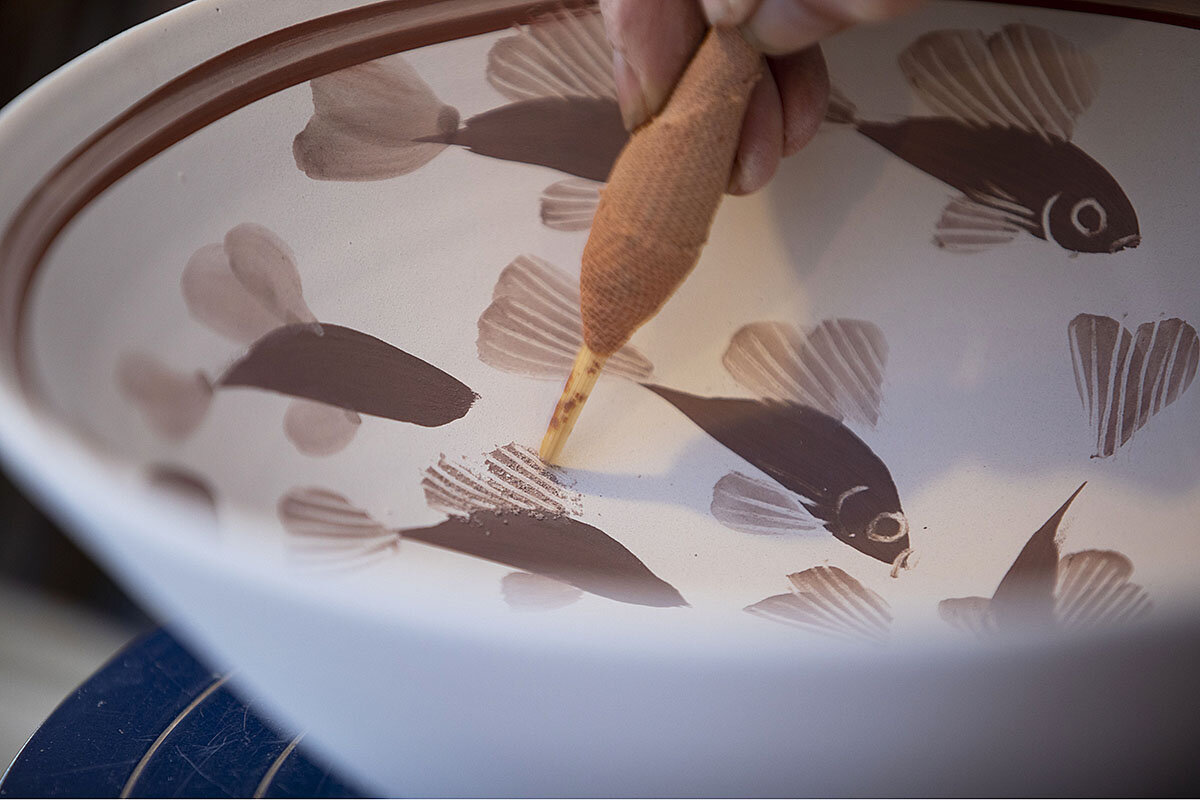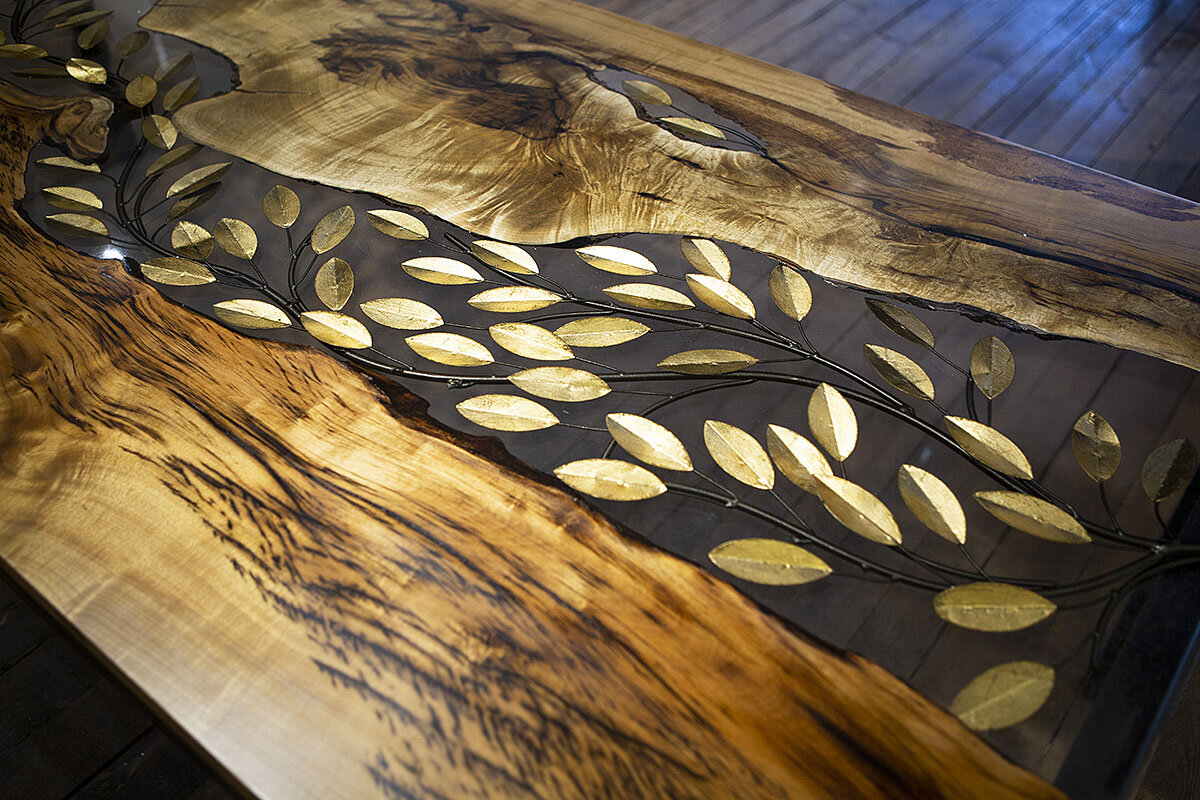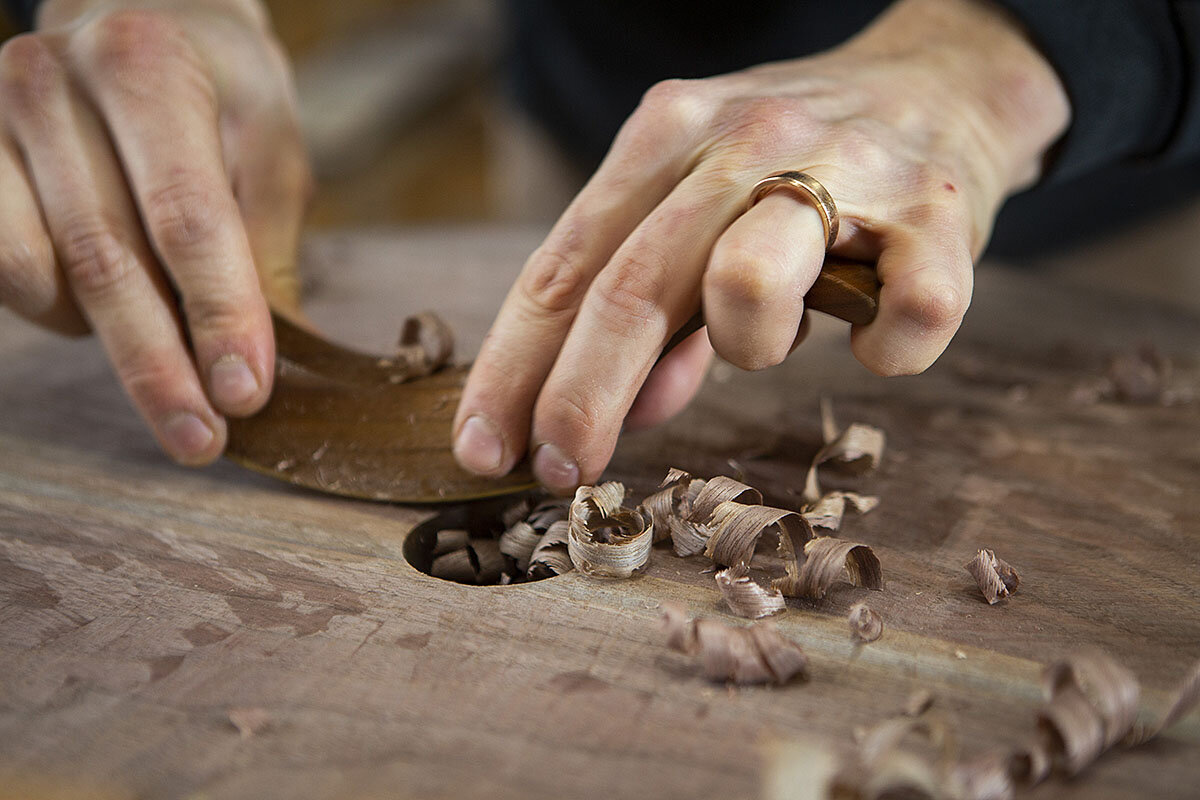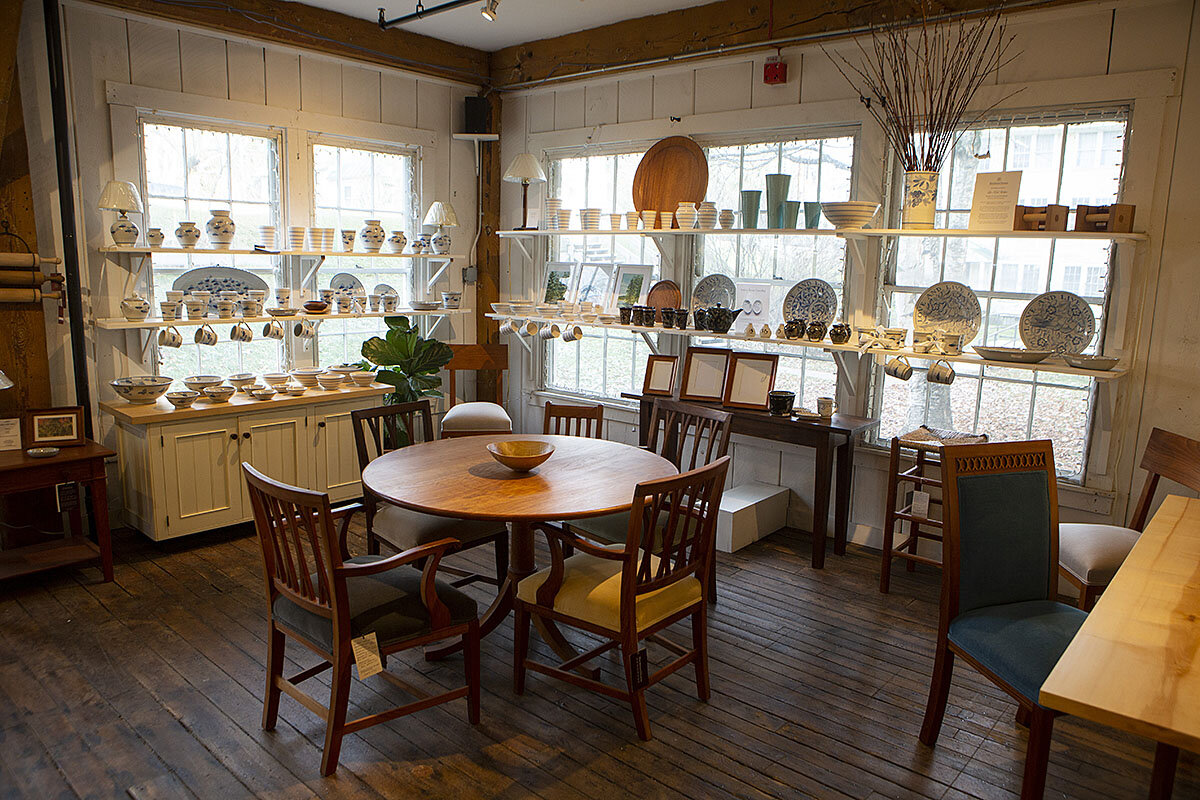The human touch: Choosing handcraft over machines
Loading...
| Bridgewater, Vt.
Optimism, persistence, and handwork. These keys to success have seen ShackletonThomas, a furniture-making and pottery business, through decades of ups and downs, including the shutdown earlier this year of its production shops due to the pandemic.
It’s not that quitting has never occurred to the owners, but they have yet to give in to the urge – in large part because the work itself rejuvenates them.
Why We Wrote This
Staying true to the practice of handcrafting, the owners of ShackletonThomas have earned international renown – and their employees have found peace in the process.
For Charles Shackleton and his wife, Miranda Thomas, who run the furniture and pottery operations, respectively, their work centers on the human touch, from design to finish.
“We believe when human beings make things, they have a character to them,” Mr. Shackleton says. “It passes on a little piece of soul, if you will.”
While the process happens in Vermont, the finished work is recognized for its beauty well beyond local borders. For example, Ms. Thomas once created a peace bowl that then-President Bill Clinton presented as a gift to Pope John Paul II.
That level of quality flows from the hands that create it. Or as their former furniture-shop manager puts it, “It’s a part of you going into somebody else’s home, and you want it to be the best part of you.”
“Optimism is true moral courage.” That’s a quote from the great Antarctic explorer Ernest Shackleton, who learned that, sometimes, the mere act of pressing on goes a long way when facing challenges. His descendant, Charles Shackleton, agrees.
“My biggest lesson from him is being able to get out of bed and put one foot in front of the other and just do it – and stuff will happen,” Mr. Shackleton says.
Optimism plus persistence has been a winning formula in uncharted waters for Mr. Shackleton and his wife, Miranda Thomas, who are at the helm of ShackletonThomas, the international business that has produced handcrafted furniture and pottery for more than 30 years out of Bridgewater, Vermont, by the scenic Ottauquechee River. The other key to success is their focus on the human touch, from design to finish.
Why We Wrote This
Staying true to the practice of handcrafting, the owners of ShackletonThomas have earned international renown – and their employees have found peace in the process.
The big challenge this year came in mid-March, when the governor’s executive order shut them down for about a month. “That was a hard hit, but we’d just shipped a lot of stuff, and we had a lot of orders,” Mr. Shackleton says.
When state rules permitted it, both workshops slowly ramped up production, with lots of work to complete. Thanks to the federal Paycheck Protection Program, they were able to keep paying their staff of about 15, and the normal flow of production had mostly returned by early November.
You wouldn’t know that for two years, the couple had been thinking of selling their part of the condoized historic Bridgewater Mill Mall property, largely because of all the exterior work it needed, including a new roof. But eventually both of their buildings got a fresh coat of paint, and Mr. Shackleton and Ms. Thomas used a loan and some of their own money to fund the roof work.
The turning point came when the exterior work began, Mr. Shackleton recalls. “We started looking at the whole thing like, ‘This is a treasure,’ whereas a year ago we were ready to give it away.”
That human touch
While painting intricate lines depicting wildlife on the outside of a mug, Ms. Thomas notes that pottery, one of the most ancient arts, takes on a deeply human feeling instilled by the one crafting it.
“There’s an energy, and if you can get that energy across, that feeling, then everybody’s happy,” she says.
For Mr. Shackleton and Ms. Thomas, who run the furniture and pottery operations, respectively, their work is the result of skilled makers, not a mechanized factory line. That lends a special human element you don’t get otherwise, Mr. Shackleton says.
“We believe when human beings make things, they have a character to them,” he says. “It passes on a little piece of soul, if you will.”
While the process happens in Vermont, the finished work has gone well beyond local borders. For example, Ms. Thomas once created a peace bowl, with a special design of peace doves, that then-President Bill Clinton presented as a gift to Pope John Paul II during the pope’s visit to St. Louis in 1999. Her pottery was also part of the celebration of Kofi Annan’s 2006 retirement from the United Nations as secretary-general.
It’s no small thing to carry on that legacy of precision and utmost quality, and now the owners’ son, Hugh Shackleton, is doing so as shop manager on the furniture side, after joining the operation more than four years ago and learning the craft.
“The coolest thing is seeing what people can create,” Hugh Shackleton says. “We are artists.”
His son’s arrival and subsequent shop-manager role were huge steps forward for the business, Mr. Shackleton says.
“It saved the business, because he brought in young inspiration, and he’s completely passionate about making things, designing things, and he’s really good at management,” Mr. Shackleton notes.
Hugh Shackleton took over the shop-manager reins from Marty Higgs, who’s worked there for 24 years and recently began training his son on furniture-making. For Mr. Higgs, the workshop has been a place of “peace and refuge.”
“There’s nothing really more relaxing than hand-planing a large tabletop,” he says, noting the side-to-side rhythm of the work and the slight “ringing” sound. “The emphasis isn’t so much on getting things done quickly, but getting things done so they’re beautiful when finished – and highly functional as well,” he adds.
Now, Mr. Higgs’ son is also enjoying that process. He finished his first table with his father’s guidance in late October.
“It’s been nice for me, especially in such a tumultuous year, to have ... some peace and focus, something to witness,” August Higgs says.
Staying the course
It takes time to build two renowned brands, and for Mr. Shackleton and Ms. Thomas, the journey began more than three decades ago. She met Mr. Shackleton, who hails from Ireland, at college in England, where they ended up in the same pottery class. After coming to Vermont at different points in the 1980s, they each ended up working for the famous craft entrepreneur Simon Pearce, who was an important mentor for them both as a craftsperson and business owner.
“Simon really talked us into it,” Ms. Thomas says, recalling striking out on their own in 1987. “He helped us get there, and we couldn’t have done this, I don’t think, without Simon.”
After taking that step, they also made a commitment to stick with handcrafting.
“We didn’t want it to become a commercial, mechanized thing, so we decided to stay with handwork,” Ms. Thomas says.
Not everyone has done the same, but this husband-and-wife team has persisted in the approach that propelled their success.
“We have made ourselves champions of the small-production workshop … and I say ‘champions’ because that’s been a goal, to really do that, so you’re putting out on the market some incredible quality,” Ms. Thomas says.
That quality flows from the hands that create it. For Marty Higgs, there’s a lasting connection between him and the pieces he crafts and signs.
“It’s a part of you going into somebody else’s home, and you want it to be the best part of you.”





